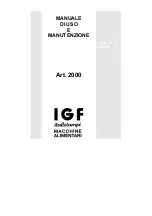
14
Parts & Service: 020 8988 7400 / E-mail: [email protected] or [email protected]
12. Bring the drill bit down to touch the workpiece surface and note the
reading on the scale on the post.
13. Move the workpiece away from the drill bit, using the longitudinal or cross
slide handles, then lower the head once again to the depth previously
noted, plus the depth of hole required. At this point, bring the limit device
up to the head and lock firmly in place. Your drill depth is now set.
14. The workpiece must ALWAYS be firmly secured. This will normally be with the
use of a vice which is securely clamped to the table. Alternatively, clamps
may be used. A suitable vice and a ‘T’ nut and clamp set designed
specifically for this machine, are available from your Clarke dealer. Please
refer to Accessories on page 25.
15. The table, carrying the workpiece, is manoeuvred using the longitudinal
and cross slide adjusting handles. Once the workpiece is positioned, any
further movement is avoided by locking both longitudinal and cross slides
in place using the locking levers provided - see parts identification Fig-B, on
page 10.
Drill speeds are effected by using either the High or Low ranges together with
the variable speed rotary switch. See notes on cutting speeds on page 16.
Never attempt to change ranges until the machine has come to a complete
stop.
MILLING
Vertical milling is similar to drilling, except that instead of the workpiece being
held stationary, it may be moved in 3 directions - A. vertically, and B.
horizontally in both axis. Milling cutters are capable of cutting with their ends
and their faces.
Several broad categories of end and face milling tools exist, such as centre
cutting versus non-centre cutting (whether the mill can take plunge cuts), and
categorisation by number of flutes, by helix angle, by material, and by coating
material. Each category may be further divided by specific application and
special geometry.
Please note that It is not within the scope of this manual to advise on types of
cutter, it is assumed that the user is familiar with milling applications, cutters
and techniques.
This machine is also capable of milling at any angle from vertical - 90º, to 45º
left or right of vertical.
INSTALLING THE CUTTER
If the chuck is installed, proceed as follows:
1. Insert the tommy bar into the hole in the side of the head so that it locates
in the hole in the spindle.
Содержание 7610860
Страница 28: ......














































